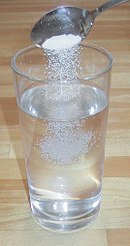Ion
![]()
The title of this article is ambiguous. For other meanings, see Ion (disambiguation).
An ion [i̯oːn] is an electrically charged atom or molecule.
Atoms and molecules in the ordinary, neutral state have as many electrons as protons. However, if an atom or molecule has one or more electrons less or more than in the neutral state, it has an electric charge as a result and is called an ion. Ions with a shortage of electrons are positively charged, those with an excess of electrons are negatively charged (see also charge number).
Fast ions moving in one direction are studied or used in atomic physics, nuclear physics and particle physics, see ion radiation, ion source or particle accelerator. A plasma (e.g. inside stars) is a disordered ensemble of ions (mostly completely ionized, i.e. electronless atomic nuclei) and the separated electrons, both moving disordered in all directions like the molecules of a gas, but much faster according to the high temperature.
The following remarks refer mainly to slow or stationary ions.
In chemistry, positively charged ions are called cations, negatively charged anions, because they migrate in an electric field as a stream of ions to the cathode ("minus pole" of the field) or to the anode ("plus pole" of the field). In a solvent, a solvate shell forms around the ion. Due to the electrostatic attraction between anions and cations, ion pairs form in solutions.
Term History
The term ion is derived from Ancient Greek ἰόν ión, German 'das Gehende' (present participle active neuter to Ancient Greek ἰέναι iénai, German 'to go').
In his investigations into electricity, Michael Faraday was dissatisfied with the terms available to him for describing chemical decompositions under the influence of electric current. He therefore turned to William Whewell, among others, at the beginning of 1834. The latter suggested the terms ion, cation and anion, among others; they have been used by Faraday ever since. They then spread rapidly in scientific nomenclature.
Formation of ions
Ions form from atoms when they donate or accept electrons. Although the separation of charges requires energy, the ions formed can be energetically favourable if they have particularly stable configurations, for example if they fulfil the octet rule.
Cations
Positively charged ions, so-called cations, are formed when atoms donate electrons. Since the atomic nucleus still has an identical, positive charge (in the neutral atom, the number of protons in the nucleus corresponds exactly to the number of electrons surrounding it), the ion appears in its entirety as a positively charged particle.
Example: metal ions are usually positively charged.
Equation for sodium ion formation: Na → Na+ + e-Equation
for magnesium ion formation: Mg → Mg2+ + 2e-
Equation for aluminum ion formation: Al → Al3+ + 3e-equation for
tin ion formation: Sn → Sn4+ + 4e-.
Anions
Negatively charged ions (anions) are formed by atoms taking up electrons. This results in an excess of electrons (negative charge carriers), which is no longer balanced by the protons (positive charge carriers) present - the negative charges predominate, the ion is negatively charged.
Example: Non-metal ions are usually negatively charged.
Equation for chloride ion formation: Cl + e- → Cl-equation
for sulfide ion formation: S + 2e- → S2-
Mobile ions form spontaneously when salts are dissolved in polar solvents (water), e.g.
The index "s" stands for Latin solidus or English solid, "solid". The index "aq" stands for aquatized.
As an example, the aqueous milieus of cells and organisms (electrolyte solution) can be mentioned. Here they play a decisive role for the electrical processes at membranes, especially for the excitability (membrane potential, action potential).

If common salt and water are mixed, the sodium and chloride ions are dissolved in the water, i.e. separated from each other and individually surrounded by water molecules.
Questions and Answers
Q: What is an ion?
A: An ion is an electrically charged atom or group of atoms. It can be made from an atom, or from a group of atoms (molecule).
Q: How are ions created?
A: Ions are created through a process called ionization, which involves making an unequal number of protons and electrons in the atom or molecule.
Q: What is the charge on a proton?
A: The charge on a proton is +1 (positively charged).
Q: What is the charge on an electron?
A: The charge on an electron is -1 (negatively charged).
Q: What happens when ions move?
A: When ions move, it creates electricity and magnetic fields.
Q: Are all ions colourless?
A: No, some ions are coloured while others are colourless. Elements in the main groups in the Periodic Table form colourless ions, while transition metals usually form coloured ions.
Search within the encyclopedia
